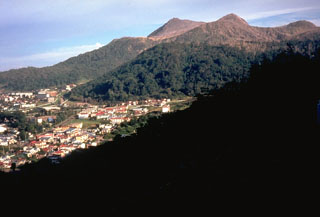Report on Toya (Japan) — September 1979
Scientific Event Alert Network Bulletin, vol. 4, no. 9 (September 1979)
Managing Editor: David Squires.
Toya (Japan) Slow seismic decline continues; elevation changes summarized
Please cite this report as:
Global Volcanism Program, 1979. Report on Toya (Japan) (Squires, D., ed.). Scientific Event Alert Network Bulletin, 4:9. Smithsonian Institution. https://doi.org/10.5479/si.GVP.SEAN197909-285030
Toya
Japan
42.544°N, 140.839°E; summit elev. 733 m
All times are local (unless otherwise noted)
Yosihiro Sawada provided the following data (table 2) on total summit area elevation changes since activity began in August 1977 [based on results from Hokkaido University]. The uplift rate at Ogari-yama was 5 cm/day in May and 3 cm/day in July.
Table 2. Total elevation change at several features on Usu, as of 31 July 1979. Courtesy of Y. Sawada.
| Location | Elevation Change |
| New cryptodome | + 159.51 m |
| Ogari-yama | + 163.26 m |
| O-Usu | - 23 m |
| Ko-Usu | - 54.8 m |
Seismicity continued to decline slowly, from an average of 54 events/day in June to 47/day in July. The actual number of events per day sometimes varied considerably from the mean; in June, daily earthquakes ranged from 5 to 293.
When inspected on 31 July, Gin-numa Crater (formed by the activity of August-October 1978) contained a pool of water. Strong fumaroles on its rim had maximum measured temperatures of 635°C.
Geological Summary. Usuzan, one of Hokkaido's most well-known volcanoes, is a small stratovolcano located astride the southern topographic rim of the 110,000-year-old Toya caldera. The center of the 10-km-wide, lake-filled caldera contains Nakajima, a group of forested Pleistocene andesitic lava domes. The summit of the basaltic-to-andesitic edifice of Usu is cut by a somma formed about 20-30,000 years ago when collapse of the volcano produced a debris avalanche that reached the sea. Dacitic domes erupted along two NW-SE-trending lines fill and flank the summit caldera. Three of these domes, O-Usu, Ko-Usu and Showashinzan, along with seven crypto-domes, were erupted during historical time. The 1663 eruption of Usu was one of the largest in Hokkaido during historical time. The war-time growth of Showashinzan from 1943-45 was painstakingly documented by the local postmaster, who created the first detailed record of growth of a lava dome.
Information Contacts: Y. Sawada, MRI, Tokyo; D. Shackelford, CA.

